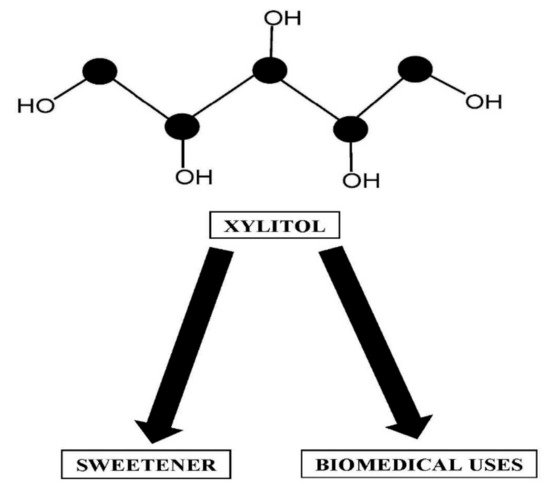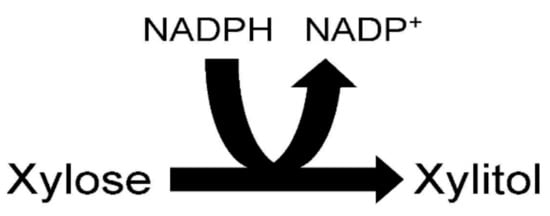2. Pathway of Xylitol Biosynthesis in the Yeast Candida
The ability of species of the yeast
Candida to produce xylitol from xylose is due to the presence of the enzyme xylose reductase within their cells. Xylose reductase (EC 1.1.1.21) catalyzes the reduction of xylose by NADPH to the polyalcohol xylitol and NADP
+ (
Figure 2). It should be mentioned that some isolated yeast xylitol reductases can also use NADH as a cofactor. There is much interest in better understanding the xylose reductase structure to improve its efficiency in producing xylitol. Better understanding of yeast xylitol reductases could lead to the genetic engineering of this enzyme so that it has a greater affinity for its substrates, resulting in increased xylitol production. An engineered high activity xylitol reductase could efficiently synthesize xylitol from the high xylose-containing agricultural residues and grasses on an industrial scale. Xylose reductase has been investigated in a number of
Candida species including
Candida tenuis,
Candida guillermondii,
Candida parapsilosis,
Candida intermedia and
Candida tropicalis [23][24][25][26][27][28][29][30][31][32].
Figure 2. Xylose reductase reaction.
The xylose reductase from
C. tenuis has been purified by dye ligand affinity chromatography and ion exchange chromatography to homogeneity
[23]. Structurally, the purified enzyme was found to be a monomer or homodimer with each subunit having a molecular weight of 36,000–43,000 daltons
[23][26]. This reductase from
C. tenuis appears to differ from other family members of the aldo-keto reductase group, which exist purely as monomers. The isoelectric point of the reductase was determined to be 4.7
[23]. The reductase prefers NADPH compared to NADH as a cofactor based on binding specificity and it has been shown that NADP
+ is a strong competitive inhibitor of the reaction
[23]. The reductase was shown to contain a catalytic tetrad consisting of tyrosine, lysine, aspartic acid and histidine residues essential to its activity
[26]. The lysine residue has been shown to be located near the coenzyme-binding site. Further, the presence of the epsilon amino group of the lysine residue in the reductase is thought to be a key element in its mode of catalysis
[26]. In a pH 7.0-buffered assay incubated at 25 °C, the
C. tenuis reductase had a K
m and k
cat of 87 mM and 18.2/s, respectively, for xylose. The reductase had a K
m of 4.8 µM and 21.9/s, respectively, for NADPH, while it had a K
m of 25.4 µM and k
cat of 18.1/s, respectively, for NADH
[23].
The xylose reductase gene fragment isolated from
C. guilliermondii ATCC 20118 was cloned into
Pichia pastoris GS115
[24]. This resulted in two xylose reductase activities being synthesized
[24]. The xylose reductase activity, secreted extracellularly, was found to utilize only NADPH as its cofactor
[24]. The molecular weight of this xylose reductase was shown to be 36,000 daltons
[24]. The reductase was composed of 317 amino acids with the pI of the reductase shown to be 5.7
[24]. It was noted that the reductase was highly hydrophobic relative to amino acid composition including many leucine residues. It was also shown that three cysteine residues and seven histidine residues were present within the reductase structure similar to the
P. pastoris xylose reductase
[24]. In
C. guilliermondii FTI 20037, a prior report characterized xylitol reductase in a crude extract prepared from cells cultured in a medium containing sugarcane bagasse hydrolysate
[25]. The kinetics of the crude reductase were analyzed and it was observed that the xylose reductase had a K
m of 64 mM for xylose and a K
m of 9.5 µM for NADPH
[25]. The optimal pH for the reductase was 5.5 and the enzyme was most stable when buffered at a pH between 5.0 and 5.5
[25]. The optimal temperature for the reductase was 65 °C and its enzyme activity was still stable after being heated to 60 °C for 10 min
[25].
In
C. intermedia, it was noted that the yeast contained two different forms of xylose reductase
[27]. The isoforms of the enzyme were purified to homogeneity by a combination of affinity chromatography and ion exchange chromatography with relatively high yields. One form of the reductase was strictly specific for NADPH as a cofactor with a K
m of 61 µM and a k
cat of 14.6/s, while its K
m and k
cat for xylose were 82 mM and 14.6/s, respectively. The second form of the reductase was able to utilize either NADPH or NADH as a cofactor
[27]. The K
m of this reductase isoform for NADPH was 56 µM and its k
cat was 11/s, while its K
m for NADH was 28 µM and its k
cat was 11.2/s. The K
m of this reductase for xylose was about 50 mM and its k
cat was about 10/s
[27]. Structurally, both isoforms exist as homodimers with individual subunits having a molecular weight of 36,000 daltons. The isoelectric point of each isoform was found to differ with the NADPH-specific isoform having a pI of 4.38, while the second form had a pI of 4.59
[27]. It is interesting to note that the number of titratable cysteines in each isoform also differed. The NADPH-specific isoform had five titratable cysteines, while the second form had only two
[27]. The inactivation of the cysteines in the NADPH-specific isoform resulted in a total loss of its activity
[27]. It was thought that the ratio of available NADPH to NADH was a determining factor as to which isoform of the reductase was most active in the
C. intermedia cells
[27].
The xylitol reductase gene in
C. parapsilosis was cloned in
Escherichia coli and the reductase was purified to homogeneity using ion exchange chromatography, affinity chromatography and preparative electrophoresis
[28]. The molecular weight of the
C. parapsilosis reductase was 36,629 daltons and was composed of 324 amino acids. The reductase was shown to have a high catalytic efficiency for xylose as a substrate. The K
m for xylose was calculated to be 31.5 mM, with its k
cat being 46/s. Interestingly, this reductase preferred NADH as its cofactor instead of NADPH
[28]. The K
m of the reductase for NADH was 3.1 µM compared to the K
m for NADPH being 36.5 µM
[28]. The k
cat of the reductase for NADH was 45.9/s relative to the k
cat for NADPH being 4.6/s
[28]. The optimal pH for the reductase was 6.0, while its temperature stability was greatest if stored at 4 °C. The reductase was subject to non-competitive inhibition by its product xylitol. The reaction mechanism for the
C. parapsilosis reductase was thought to be an ordered sequential bi bi mechanism as has been proposed for other xylitol reductases
[28].
In
C. tropicalis, the properties of xylose reductase have been investigated
[30][31][32]. The xylose reductase from
C. tropicalis has been purified by cloning the xylitol reductase gene into
Escherichia coli [30]. The purified reductase was crystalized and analyzed using X-ray diffraction
[30]. The properties of a crude xylitol reductase activity isolated from a strain of
C. tropicalis adapted to a hydrolysate of tree sawdust were studied
[31]. The reductase was shown to be specific for NADP
+ as its cofactor
[31]. The reductase was still 95% active following 120 days at −80 °C. Further, the reductase was observed to be stable at a pH range between pH 5 and 7. The crude enzyme was stable for 24 h when incubated between 25 and 40 °C. The K
m of the reductase was calculated to be 81.78 mM for xylose and 7.29 µM for NADPH
[31]. The V
max of the enzyme for xylose and NADPH was 178.57 µM/min and 12.5 µM/min, respectively
[31]. The K
m and V
max values for the reductase were thought to be associated with the high rate of xylitol production noted by the strain. The molecular weight of the reductase was 36,600 daltons
[30]. Another study using recombinant versions of the
C. tropicalis reductase found that a serine residue at position 279 of its structure allowed increased catalysis compared to the presence of a leucine or an asparagine residue at position 279
[32]. The importance of a serine residue at position 279 of the reductase was thought to involve the binding of NADPH
[32].
In summary, when comparing the previously investigated xylose reductases isolated from various species of Candida, there appear to be some similarities. First, the xylose reductases isolated from species of Candida appear to exhibit similar molecular weights. In general, the pH optimum of many of the characterized reductases from Candida species was similar. In addition, some of the reductases synthesized by the Candida species had a strict cofactor requirement for NADPH, while some synthesized a reductase activity that preferred NADPH as a cofactor but could still use NADH as a cofactor to catalyze the reaction. With respect to the kinetic properties of the Candida xylose reductases, the affinity of the enzymes for the nicotinamide cofactor was usually much greater than their affinity for xylose as a substrate.


